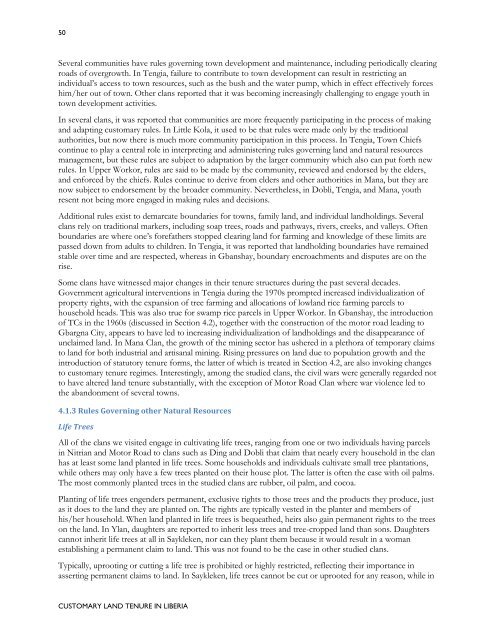Customary Land Tenure in Liberia - Land Tenure and Property ...
Customary Land Tenure in Liberia - Land Tenure and Property ...
Customary Land Tenure in Liberia - Land Tenure and Property ...
You also want an ePaper? Increase the reach of your titles
YUMPU automatically turns print PDFs into web optimized ePapers that Google loves.
50<br />
Several communities have rules govern<strong>in</strong>g town development <strong>and</strong> ma<strong>in</strong>tenance, <strong>in</strong>clud<strong>in</strong>g periodically clear<strong>in</strong>g<br />
roads of overgrowth. In Tengia, failure to contribute to town development can result <strong>in</strong> restrict<strong>in</strong>g an<br />
<strong>in</strong>dividual‟s access to town resources, such as the bush <strong>and</strong> the water pump, which <strong>in</strong> effect effectively forces<br />
him/her out of town. Other clans reported that it was becom<strong>in</strong>g <strong>in</strong>creas<strong>in</strong>gly challeng<strong>in</strong>g to engage youth <strong>in</strong><br />
town development activities.<br />
In several clans, it was reported that communities are more frequently participat<strong>in</strong>g <strong>in</strong> the process of mak<strong>in</strong>g<br />
<strong>and</strong> adapt<strong>in</strong>g customary rules. In Little Kola, it used to be that rules were made only by the traditional<br />
authorities, but now there is much more community participation <strong>in</strong> this process. In Tengia, Town Chiefs<br />
cont<strong>in</strong>ue to play a central role <strong>in</strong> <strong>in</strong>terpret<strong>in</strong>g <strong>and</strong> adm<strong>in</strong>ister<strong>in</strong>g rules govern<strong>in</strong>g l<strong>and</strong> <strong>and</strong> natural resources<br />
management, but these rules are subject to adaptation by the larger community which also can put forth new<br />
rules. In Upper Workor, rules are said to be made by the community, reviewed <strong>and</strong> endorsed by the elders,<br />
<strong>and</strong> enforced by the chiefs. Rules cont<strong>in</strong>ue to derive from elders <strong>and</strong> other authorities <strong>in</strong> Mana, but they are<br />
now subject to endorsement by the broader community. Nevertheless, <strong>in</strong> Dobli, Tengia, <strong>and</strong> Mana, youth<br />
resent not be<strong>in</strong>g more engaged <strong>in</strong> mak<strong>in</strong>g rules <strong>and</strong> decisions.<br />
Additional rules exist to demarcate boundaries for towns, family l<strong>and</strong>, <strong>and</strong> <strong>in</strong>dividual l<strong>and</strong>hold<strong>in</strong>gs. Several<br />
clans rely on traditional markers, <strong>in</strong>clud<strong>in</strong>g soap trees, roads <strong>and</strong> pathways, rivers, creeks, <strong>and</strong> valleys. Often<br />
boundaries are where one‟s forefathers stopped clear<strong>in</strong>g l<strong>and</strong> for farm<strong>in</strong>g <strong>and</strong> knowledge of these limits are<br />
passed down from adults to children. In Tengia, it was reported that l<strong>and</strong>hold<strong>in</strong>g boundaries have rema<strong>in</strong>ed<br />
stable over time <strong>and</strong> are respected, whereas <strong>in</strong> Gbanshay, boundary encroachments <strong>and</strong> disputes are on the<br />
rise.<br />
Some clans have witnessed major changes <strong>in</strong> their tenure structures dur<strong>in</strong>g the past several decades.<br />
Government agricultural <strong>in</strong>terventions <strong>in</strong> Tengia dur<strong>in</strong>g the 1970s prompted <strong>in</strong>creased <strong>in</strong>dividualization of<br />
property rights, with the expansion of tree farm<strong>in</strong>g <strong>and</strong> allocations of lowl<strong>and</strong> rice farm<strong>in</strong>g parcels to<br />
household heads. This was also true for swamp rice parcels <strong>in</strong> Upper Workor. In Gbanshay, the <strong>in</strong>troduction<br />
of TCs <strong>in</strong> the 1960s (discussed <strong>in</strong> Section 4.2), together with the construction of the motor road lead<strong>in</strong>g to<br />
Gbargna City, appears to have led to <strong>in</strong>creas<strong>in</strong>g <strong>in</strong>dividualization of l<strong>and</strong>hold<strong>in</strong>gs <strong>and</strong> the disappearance of<br />
unclaimed l<strong>and</strong>. In Mana Clan, the growth of the m<strong>in</strong><strong>in</strong>g sector has ushered <strong>in</strong> a plethora of temporary claims<br />
to l<strong>and</strong> for both <strong>in</strong>dustrial <strong>and</strong> artisanal m<strong>in</strong><strong>in</strong>g. Ris<strong>in</strong>g pressures on l<strong>and</strong> due to population growth <strong>and</strong> the<br />
<strong>in</strong>troduction of statutory tenure forms, the latter of which is treated <strong>in</strong> Section 4.2, are also <strong>in</strong>vok<strong>in</strong>g changes<br />
to customary tenure regimes. Interest<strong>in</strong>gly, among the studied clans, the civil wars were generally regarded not<br />
to have altered l<strong>and</strong> tenure substantially, with the exception of Motor Road Clan where war violence led to<br />
the ab<strong>and</strong>onment of several towns.<br />
4.1.3 Rules Govern<strong>in</strong>g other Natural Resources<br />
Life Trees<br />
All of the clans we visited engage <strong>in</strong> cultivat<strong>in</strong>g life trees, rang<strong>in</strong>g from one or two <strong>in</strong>dividuals hav<strong>in</strong>g parcels<br />
<strong>in</strong> Nitrian <strong>and</strong> Motor Road to clans such as D<strong>in</strong>g <strong>and</strong> Dobli that claim that nearly every household <strong>in</strong> the clan<br />
has at least some l<strong>and</strong> planted <strong>in</strong> life trees. Some households <strong>and</strong> <strong>in</strong>dividuals cultivate small tree plantations,<br />
while others may only have a few trees planted on their house plot. The latter is often the case with oil palms.<br />
The most commonly planted trees <strong>in</strong> the studied clans are rubber, oil palm, <strong>and</strong> cocoa.<br />
Plant<strong>in</strong>g of life trees engenders permanent, exclusive rights to those trees <strong>and</strong> the products they produce, just<br />
as it does to the l<strong>and</strong> they are planted on. The rights are typically vested <strong>in</strong> the planter <strong>and</strong> members of<br />
his/her household. When l<strong>and</strong> planted <strong>in</strong> life trees is bequeathed, heirs also ga<strong>in</strong> permanent rights to the trees<br />
on the l<strong>and</strong>. In Ylan, daughters are reported to <strong>in</strong>herit less trees <strong>and</strong> tree-cropped l<strong>and</strong> than sons. Daughters<br />
cannot <strong>in</strong>herit life trees at all <strong>in</strong> Saykleken, nor can they plant them because it would result <strong>in</strong> a woman<br />
establish<strong>in</strong>g a permanent claim to l<strong>and</strong>. This was not found to be the case <strong>in</strong> other studied clans.<br />
Typically, uproot<strong>in</strong>g or cutt<strong>in</strong>g a life tree is prohibited or highly restricted, reflect<strong>in</strong>g their importance <strong>in</strong><br />
assert<strong>in</strong>g permanent claims to l<strong>and</strong>. In Saykleken, life trees cannot be cut or uprooted for any reason, while <strong>in</strong><br />
CUSTOMARY LAND TENURE IN LIBERIA

















